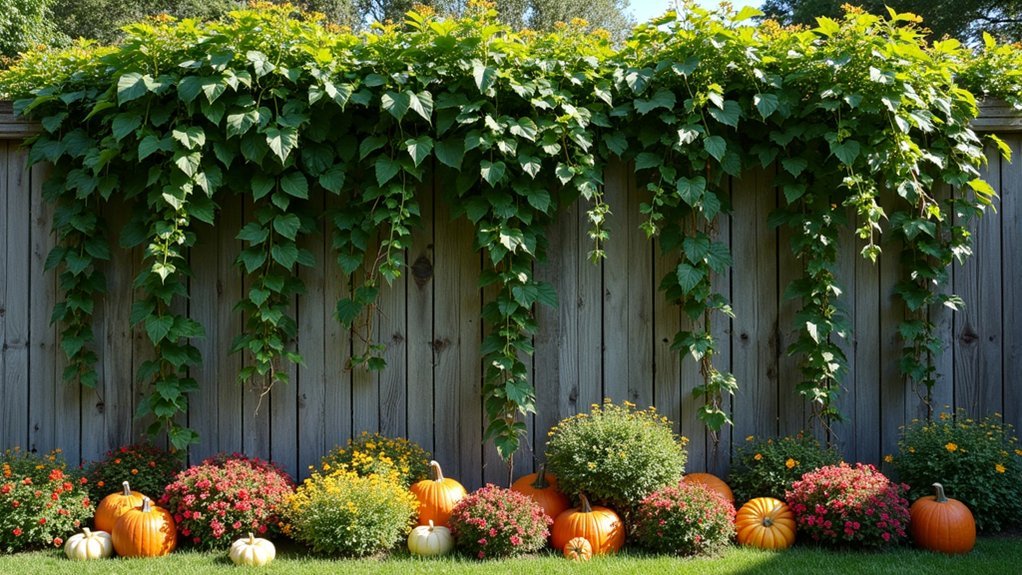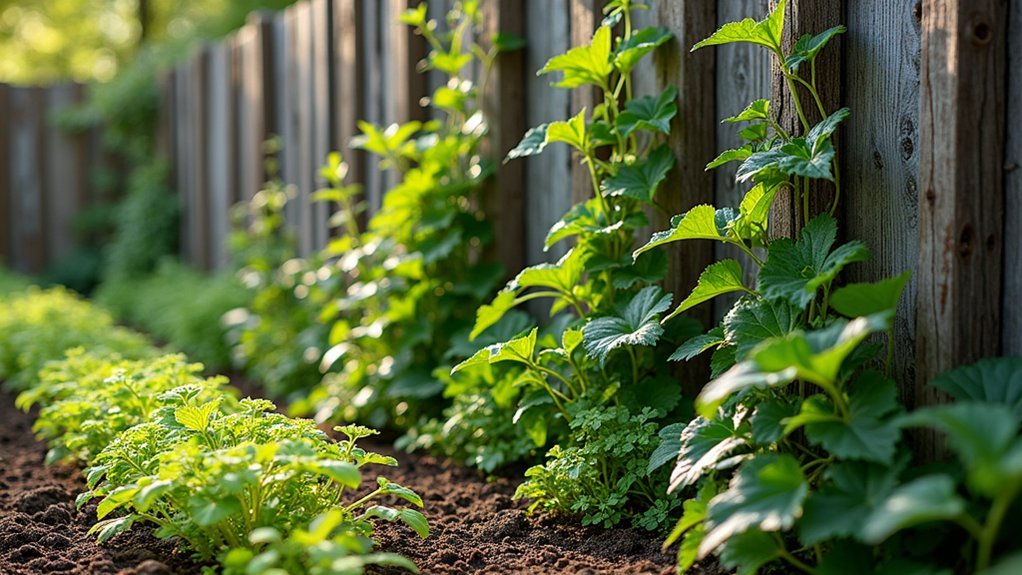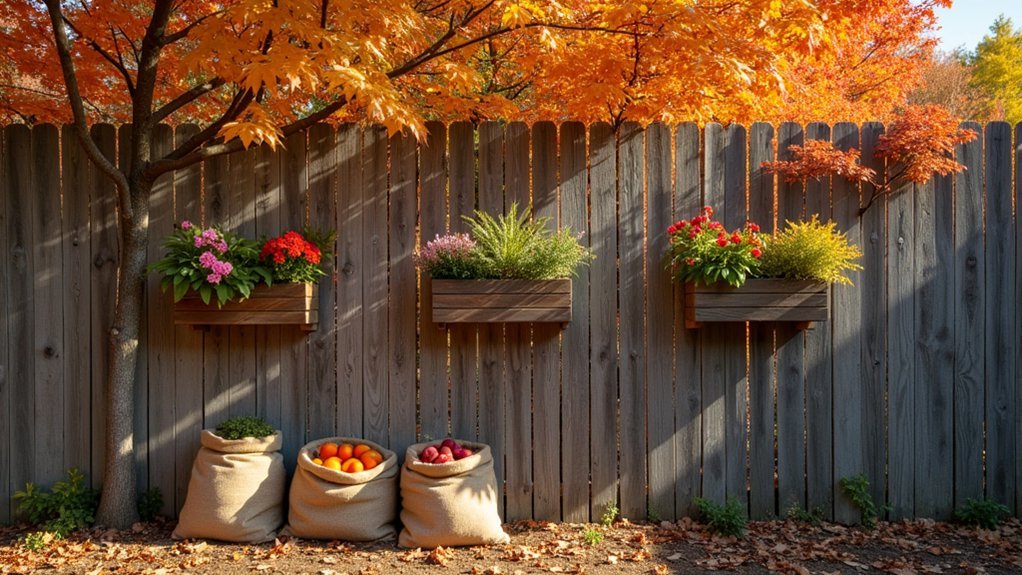Seasonal fence planning transforms boundaries into productive growing spaces. You’ll need to assess your fence type—chain-link works best for climbers, while wooden fences may require additional trellises. Start spring with peas and beans, manage summer heat with drip irrigation and mulch, harvest before fall frosts, and prepare for winter with proper cleanup and insulation. With thoughtful planning each season, your vertical garden fence will yield beautiful, functional results throughout the year.
Seasonal Fence Planning for Vertical Garden Boundaries

While traditional gardens spread horizontally across valuable yard space, vertical gardening transforms ordinary fences into productive growing zones. Effective seasonal fence planning allows you to leverage existing boundaries as support structures for climbing plants throughout the year.
Maximize limited real estate by turning everyday fence lines into flourishing vertical landscapes for year-round cultivation.
Assess your fence types strategically – chain-link naturally accommodates climbing vegetables like cucumbers and peas, while solid wood fences need grids or trellises attached.
Remember that most vertical crops are annuals, requiring replanting each season to maintain vibrant garden boundaries.
Position your garden elements to maximize growing conditions. Solid panel fencing can provide sunlight reflection in early spring and block cold winds in fall, extending your harvest season.
With thoughtful planning, you’ll transform boundary fences from simple dividers into productive space that yields vegetables throughout multiple growing seasons.
Assessing Your Fence Structure for Year-Round Vertical Growing
Before investing time and resources in your vertical garden, you’ll need to thoroughly evaluate your fence structure to ascertain it can support plants throughout all seasons.
Chain-link fencing offers ideal sturdy support for climbing plants, while wood fences may require additional trellises.
For successful vertical garden implementation, confirm your fence stands at least 6 feet tall to accommodate tomatoes and cucumbers that thrive with extra height.
South-facing fences create warm microclimates that extend the growing season for heat-loving plant varieties by several weeks.
Check your fence’s stability—heavier vining plants demand robust structures.
Damaged fencing can compromise your garden’s safety and productivity.
When planning for seasonal changes, select annual crops that flourish during warmer months, and remember to rotate plantings to maintain soil health throughout the year.
Spring Planning: Selecting Early Season Climbers and Support Systems

With your fence foundation assessed, springtime brings exciting opportunities for vertical growing. Start by preparing soil with organic compost, then select early-season climbers like peas and pole beans that thrive in cooler temperatures once soil becomes workable. When installing support systems, verify trellises or mesh are securely attached to your existing fence.
| Plant Type | Planting Density | Recommended Support |
|---|---|---|
| Peas | 2-3″ apart | Mesh netting |
| Pole Beans | 4-6″ apart | Bamboo teepees |
| Cucumbers | 12-18″ apart | Strong trellis |
| Tomatoes | 18″ apart | Cage systems |
| Squash | 24″ apart | Heavy-duty grid |
Remember proper planting density is essential—space cucumber and tomato plants 12-18 inches apart for adequate airflow. Implement companion planting by pairing beans with corn to maximize vertical space and enhance overall yield.
Summer Strategies: Managing Heat and Water for Fence-Mounted Plants
As temperatures climb during summer months, your fence-mounted garden faces new challenges that require strategic management.
Install a drip irrigation system to efficiently hydrate your vertical plants while reducing water waste by up to 50%.
Apply mulch around plant bases to retain soil moisture and lower soil temperatures by 5-10°F.
Position plants with high water requirements like tomatoes and cucumbers near the fence base to benefit from heat reflection while maintaining hydration.
During intense heat, use shade cloth to protect vulnerable foliage from sunburn and stress.
Regularly check soil moisture with a moisture meter to prevent overwatering or underwatering.
These summer strategies help maintain best growth conditions for your fence-mounted plants, ensuring they thrive despite the season’s challenges.
Fall Transition: Harvesting and Preparing Vertical Spaces for Winter

The arrival of fall signals the important time to begin your vertical garden’s shift toward winter dormancy.
Prioritize harvesting all remaining crops from your vertical spaces before frost damages them, ensuring no produce goes to waste.
Fall urgency: harvest what remains from vertical gardens before frost claims what you’ve worked so hard to grow.
Once harvested, remove all dead plant material from your structures to prevent disease and pest overwintering.
This maintenance is essential for next season’s success.
For soil health, consider planting cover crops or applying mulch around vertical supports to prevent erosion during winter months.
If you’re growing perennial climbing plants like grapes or kiwis, prune them according to their specific requirements to encourage robust spring growth.
Finally, install protective barriers or row covers around vulnerable vertical garden areas to shield plants from harsh winter weather and potentially extend your growing season.
Winter Protection: Maintaining Living Boundaries During Dormant Months
Winter’s arrival doesn’t mean your living fence maintenance stops entirely. Your living fences require minimal attention during dormant months, with evergreen plants continuing to provide visual interest and protection against harsh elements. Focus on monitoring soil moisture levels, as even dormant plants need occasional watering during dry spells.
| Winter Task | Frequency | Benefits |
|---|---|---|
| Apply mulch | Once early winter | Root insulation and moisture retention |
| Limited pruning | As needed | Removal of dead branches improves health |
| Row covers | Before freezes | Temperature stabilization for sensitive plants |
Avoid extensive pruning during winter; instead, concentrate on removing damaged branches to enhance structure. Adding mulch creates essential insulation for root systems while suppressing weeds. For additional winter protection, incorporate thermal mass elements near vulnerable sections of your living boundaries to maintain consistent temperatures.
Frequently Asked Questions
How Do Fence-Mounted Gardens Affect Neighboring Property Relationships?
Fence-mounted gardens can improve your neighbor relationships when you maintain them well and discuss plans beforehand. They’ll appreciate your consideration regarding overflow, maintenance access, and how the aesthetic enhances both properties.
Can Vertical Garden Fences Effectively Reduce Noise Pollution?
Yes, vertical garden fences can reduce noise pollution. You’ll notice they absorb sound waves through multiple layers of plants, soil, and materials. They’re most effective when you use dense foliage and thick growing mediums.
What Insurance Considerations Exist for Fence-Mounted Growing Systems?
You’ll need liability coverage if someone’s injured by your fence-mounted systems. Consider property insurance for storm damage, weight-related structural failures, and water damage to your fence from irrigation systems.
How Do Vertical Garden Boundaries Impact Local Wildlife Corridors?
Your vertical garden boundaries can either fragment wildlife movement or enhance biodiversity. You’ll create better corridors by including gaps for small animals, using native plants, and avoiding solid barriers that block natural pathways.
Are There Municipality Restrictions on Height for Living Fence Boundaries?
Yes, you’ll find most municipalities have specific height restrictions for living fence boundaries. These typically range from 3-6 feet in front yards and 6-8 feet in backyards. Check your local zoning codes.
In Summary
You’ll find fences offer endless possibilities for vertical gardening throughout the seasons. By carefully planning your support systems, selecting appropriate climbers, and maintaining proper care regimes, you’ve created a living boundary that transforms with each passing month. Remember, your fence isn’t just a property divider—it’s a dynamic growing space that rewards your seasonal attention with beauty and productivity year-round.





Leave a Reply